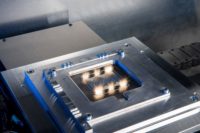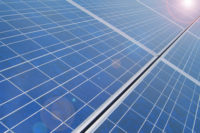New DC-DC Converter Boosts Fuel Cell Efficiency

ERLANGEN, Germany—Fuel cell systems that convert hydrogen into electricity hold tremendous promise to power future aircraft, ships, trains and trucks. However, to make each vehicle energy-efficient, individual components need to be as light and small as possible.
One key component of fuel cells is the DC-DC converter. It modulates voltage to suit the drive and control the flow of energy.
Engineers at the Fraunhofer Institute for Integrated Systems and Device Technology (IISB) recently developed a new generation of DC-DC converters that achieve very high efficiency despite their extremely compact footprint.
“While conventional DC-DC converters have an efficiency of around 97 percent to 98 percent, ours achieves up to 99 percent,” says Berndt Eckardt, Ph.D., an engineer who specializes in power electronics. “This may not sound like much at first, but it means that the losses are more than halved, and every tenth of a percent matters.
“After all, 200,000 watts of power flow through the converter,” notes Eckardt. “A loss rate of 1 percent would mean that 2 kilowatts of power dissipate in the form of heat.”
While today’s electrical converters for fuel cells occupy around 10 liters of installation space, the Fraunhofer IISB converter takes up just half as much room.
“In conjunction with its high efficiency factor, this is a sensational advance given that high switching frequencies and small components are generally said to cause greater losses,” explains Eckardt.
“What we’ve achieved was thought to be impossible,” claims Eckardt. “What made it possible was delving deeper into the physical effects of circuits and components. It is this attention to detail that enabled us to understand and take advantage of new physical effects. This led to new switching methods, among other things.
“What’s more, new technologies are constantly emerging,” adds Eckardt. “Our colleagues and specialized companies from the relevant fields are developing ever more powerful individual components, which we as a team can combine to create increasingly powerful converters.”
Looking for a reprint of this article?
From high-res PDFs to custom plaques, order your copy today!





